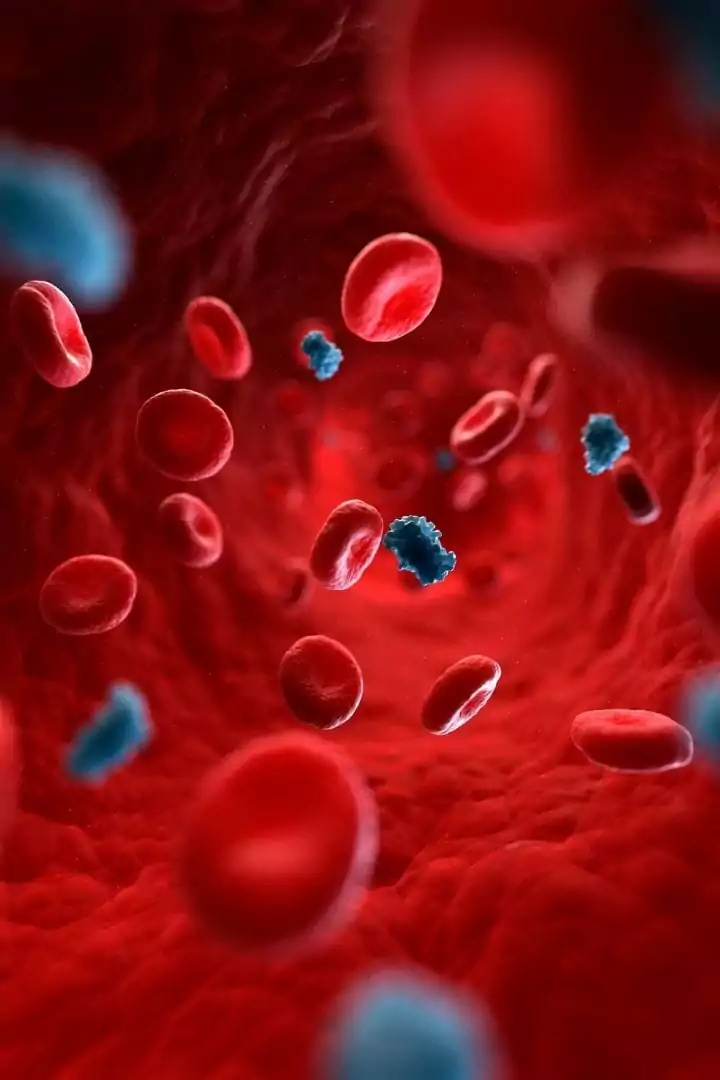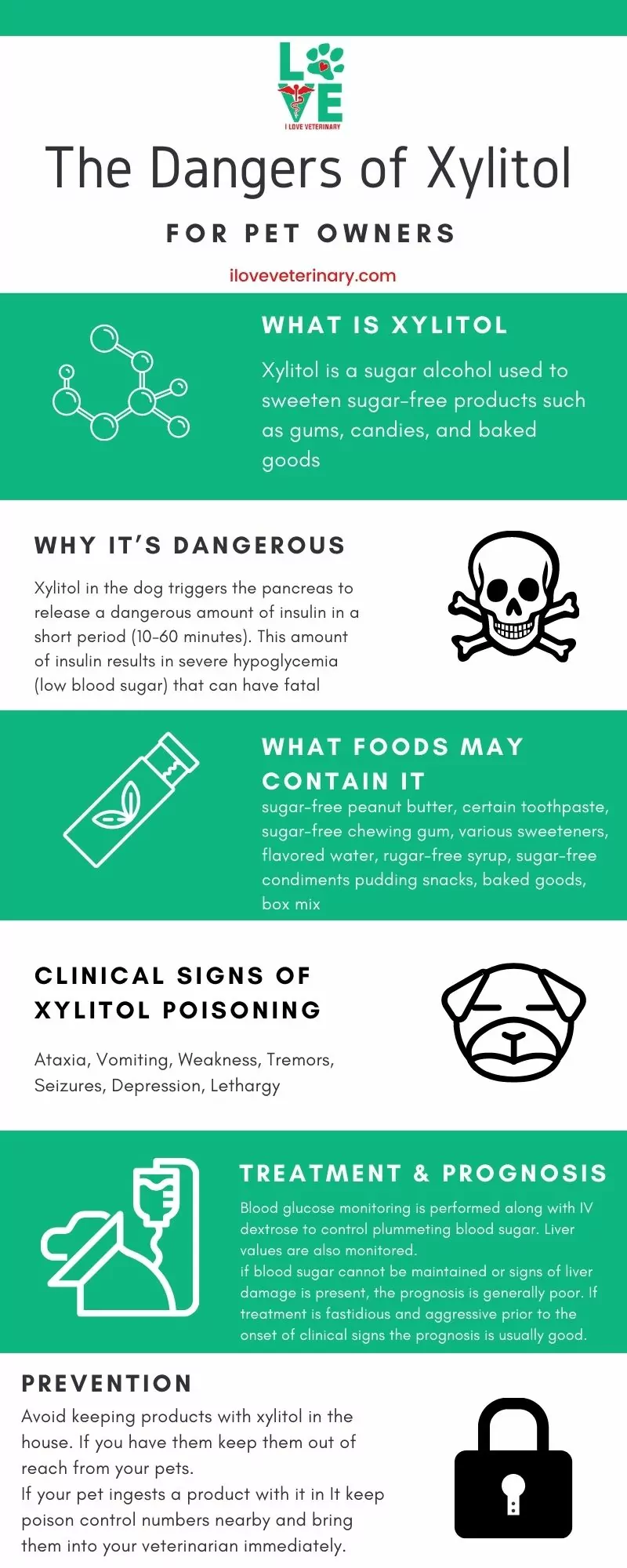What is Xylitol?
In a health-crazed world, sugar-free food items are all the rave. For our furry dog friends, however, they are downright dangerous. Xylitol is a sugar alcohol used to sweeten sugar-free products such as gums, candies, and baked goods 1. It may be beneficial to a human diabetic or someone watching their weight, but it can be deadly for dogs.

Foods Containing Xylitol
Knowing which foods contain Xylitol is key when avoiding feeding them to your dog. Of course, dogs should not be fed table food and adhere to a dog food-only diet. But we know that they tend to be spoiled and dabble in human food.
We may drop things on the floor as well by accident or have dangerous foods in the house. Dogs are scavengers, so they can be pretty crafty when it comes to getting what they want. The safest way to avoid Xylitol toxicity is by avoiding having these foods in your household. Below is a list of common foods that contain Xylitol:
- sugar-free peanut butter
- Certain toothpaste
- Sugar-free chewing gum
- Various sweeteners
- Flavored water
- Sugar-free syrup
- Sugar-free condiments
- Pudding snacks
- Baked goods box mix
For more information on products containing Xylitol, watch this video:
Why Xylitol is Popular
Xylitol is a simple fix to a sugar fiend who does not want to pack on the pounds. Tasting as sweet as sugar, but being 2/3r less of the calories is quite appealing. First, it was found in oral care products such as chewing gum, and toothpaste, but has quickly risen to be present in many more foods and products. Also, it’s essential to note that people with diabetes are often in need of foods with a low glycemic index that keeps their sugar under control but still allows their sweet tooth to be satiated.
It may cause a slight aperient effect on humans, but that is the extent of its negative aspect. Unlike the hazardous and deadly consequences, it has for dogs.
Why is Xylitol Toxic to Dogs
In order to understand Xylitol toxicity, we first need to know how insulin works in the body. Insulin is a hormone released by the pancreas to control blood sugar. When humans eat something containing Xylitol, it does not affect their insulin.
However, when your dog consumes it, it has detrimental results. Xylitol in the dog triggers the pancreas to release a dangerous amount of insulin in a short period (10-60 minutes). This amount of insulin results in severe hypoglycemia (low blood sugar) that can have fatal consequences if left untreated.

How much Xylitol is Poisonous to a Dog?
The amount of a substance consumed is what makes something poisonous. However, it does not take much for a dog to show clinical signs of Xylitol poisoning. Depending on the dog’s size and amount ingested will help determine what treatment needs to be done.
It’s always essential to have all the information on hand, so that your veterinarian can best suit your dog’s needs. The LD50 (the lethal dose that causes 50% of fatalities) of Xylitol is >0.1g/kg of body weight for dogs.
Symptoms to Look For in Your Dog if it Eats Something with Xylitol
Xylitol’s main clinical sign is hypoglycemia which will cause many clinical signs. These clinical signs include but are not limited to:
- Ataxia (impaired coordination)
- Vomiting
- Weakness
- Tremors
- Seizures
- Depression
- Lethargy
How is Xylitol poisoning Diagnosed
A thorough history is vital when it comes to diagnosing Xylitol poisoning. As far as quantitative tests, a spot blood glucose and blood work will help aid in treatment.
Due to how fast your dog’s bloodstream absorbs the Xylitol, tests often follow treatment. Treatment should be done first because timing is key to a good prognosis.

How is xylitol poisoning treated?
Depending on how long ago your dog consumed, Xylitol induced vomiting can be performed by your veterinarian. However, it’s often already absorbed into your dog’s system, and inducing vomiting would be pointless.
Blood glucose monitoring is performed frequently along with IV dextrose to control plummeting blood sugar. Liver values are also monitored, and if needed, supplemental drugs are given to protect the liver.
Your dog should stay on IV dextrose and be monitored until it can maintain a regular blood sugar without any supplements. Liver drugs such as hepatoprotectives, vitamin K, and antibiotics can be given to help avoid further (if any) liver damage.
Prognosis of Xylitol Poisoning
Prognosis is based on your dog’s clinical signs. If your dog cannot maintain their blood sugar or show signs of liver damage, the prognosis is generally poor. If your dog’s treatment is fastidious and aggressive prior to the onset of clinical signs the prognosis is usually good.
How To Protect Your Dog From Xylitol Poisoning
Prevention is the best form of treatment when it comes to Xylitol poisoning. By not keeping products in your household that contain this ingredient, you limit the chance of your dog becoming sick from it.
If this is not possible, then be sure to keep any products containing Xylitol in a high, locked cabinet where dogs and small children can not reach it. Also, educating yourself and others about the dangers of Xylitol will help bring awareness and allow for more careful handling of Xylitol- containing products.
If you keep sugar free gum in your purse, make sure to keep it off the floor, as well as warn others to do the same. Dogs are notorious for scavenging food and will not hesitate to go through your bag. By the time you notice your bag is undone, it is usually too late, and the poisoning has already begun.

Search for labels and read the product list to make sure you are aware of any dangerous ingredients. While on walks, make sure your dog doesn’t stick its nose where it doesn’t belong. Keep it on a tight leash and be aware if they decide to eat anything.
Make sure when also giving OTC (over the counter) medications that they do not contain this ingredient and if they do to alert your veterinarian. Read our article and find out Human Medications That Are Poisonous To Pets.
Keep an eye on your pet and avoiding sharing table food with them will further protect them from Xylitol poisoning. Keeping numbers for pet poison control somewhere visible is also a good idea in case of emergency. Listed below are some commonly used ones:
ASPCA- (888) 426-4435
Pet Poison Control Center- (855) 764-7661
They also have correlating websites that can be of some assistance in an emergency. :
ASPCA website – Animal Poison Control
Removing the poison from your pet’s body is always the best idea in cases such as these, but when that’s not an option, the pet poison control hotline will help direct the best path for your dog. They will also give you a timeline and the suggested treatment to give your dog that your veterinarian can follow.

Summary
As dog owners, it’s imperative that we stay educated about the dangers lurking in our cabinets. Sometimes it is unavoidable; that’s why it’s important to anticipate problems and act quickly when they occur.
Keeping in mind how rapid the onset of toxicity is with Xylitol is a crucial element of a good prognosis. Also, alerting owners of its dangers when they come in for routine visits can help avoid future tragedies.
Infographic about the dangers of Xylitol toxicity in Dogs

- Gwaltney-Brant, By, Gwaltney-Brant, & Last full review/revision May 2013 | Content last modified May 2013
